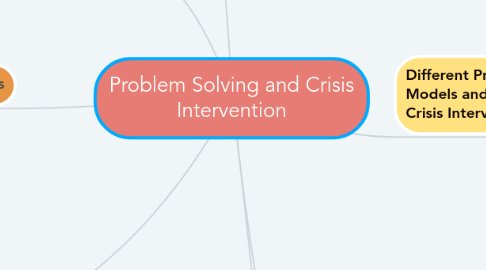
1. Problem as Crises and Crises as Problems
1.1. Crisis: Attack of pain, distress, or disordered function
1.2. Problem: Any life situation or task that demand a response for adaptive functioning
2. Interpersonal Problem-Solving Models
2.1. 1. Problem Orientation: The motivational base of problem solving is almost always a given
2.2. 2. Problem-solving proper: The process which an individual attempts to find an effective or adaptive solution to the crisis through the rational application of problem-solving strategies
3. The role and impact of Emotions
3.1. The IPS model teaches an individual to use emotion as a cue to begin to problem-solve.
3.2. The emotional aspect of crisis situations creats a special problem for training in IPS.
4. Análisis Crítico Personal
4.1. Los seres humanos tenemos mayor capacidad para resolver problemas. Sin embargo, las capacidades de resolución de problemas varían entre personas. Hay algunas que pueden resolver grandes problemas y otras que no. Por ello, la manera en la que pensamos en la resolución de dichos problemas es determinante para aprovechar las oportunidades, evitar costes, no perder desmotivación y no generar estrés. Los problemas están estrechamente relacionados con nuestras emociones, pues analizamos en función del placer o el dolor generado por la acción.
5. Ejemplos
5.1. 1. Un joven de 25 años consigue un trabajo temporal de verano para poder pagarse el año universitario siguiente. No obstante, lo despiden al mes. Un pensamiento automático sería: 'No hay solución, este año no podré estudiar'. Por el contrario, pensar en una solución sería encontrar opciones y pasos que le permitan guiarse hacia la resolución del problema.
5.2. 2. Una mujer de 30 años con una hija pasa por un divorcio luego de diez años de relación. Piensa que se quedará sola, no tendrá cómo mantener a su hija y nunca conseguirá un trabajo. Sin embargo, buscar soluciones al problema conllevan una serie de pasos: Buscar ayuda psicológica, creen en si misma, etc.
6. Different Problem-Solving Models and their relevance for Crisis Intervention
6.1. Spivack and Shure's Model
6.1.1. MEPS (means-ends problem solving)
6.2. Elias's Model
6.2.1. 1. Look for sings
6.2.2. 2. Define crisis
6.2.3. 3. Dicide on your goal
6.2.4. 4. Think of as many solutions as you can
6.2.5. 5. For each, think what might happen next
6.2.6. 6. Choose your best solution
6.2.7. 7. Plan it and make a final check
6.2.8. 8. Try it and rethink it
6.3. Goldfriend, D'Zurilla and Nezu's Model
6.3.1. They offer the most comprehensive and integrative model available for coping with crises
7. Crises coping through problem solving: The process
7.1. - Problem-Solving Orientation
7.1.1. Self-efficacy
7.1.2. Outcome expectancy
7.2. - Problem-Solving Proper
7.2.1. 1. Attempting to identify and 'accept' a crisis when it occurs
7.2.2. 2. Defining the crisis by formulating in your own words what the crisis is about
7.2.3. 3. Attempting to understand the crisis
7.2.4. 4. Setting reasonable goals
7.2.5. 5. Generating alternative behavioral and emotional coping with crisis situations
7.2.6. 6. Evaluating the more promising of the alternatives
7.2.7. 7. Implementing the chosen alternatives
7.2.8. 8. Evaluating the efficacy of the process and taking corrective action at one of the previous stages

